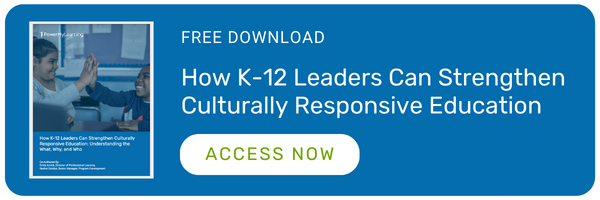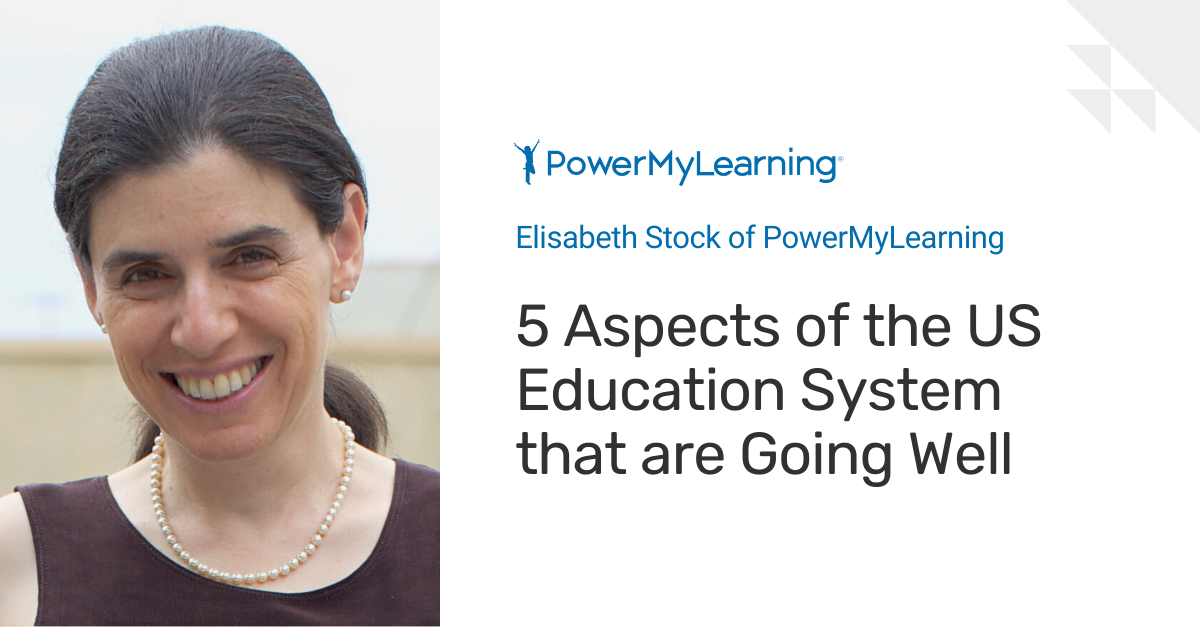How K-12 Leaders Can Strengthen Culturally Responsive Education
Co-Authored By:
Emily Amick, Director of Professional Learning
Rachel Gordon, Senior Manager, Program Development
Culturally responsive education practices are essential to the social, emotional and academic development of all students. Now more than ever, we need to take a hard look at both our practices and systems to build a culturally responsive environment that connects students, teachers, and families.
In this blog post, we will answer three important questions:
- What Is Culturally Responsive Education?
- Why Is Culturally Responsive Education Important?
- Who Is Culturally Responsive Education for?
Download a PDF copy of "How K-12 Leaders Can Strengthen Culturally Responsive Education."
1. What is Culturally Responsive Education?
Culturally responsive education, culturally relevant pedagogy, and culturally sustaining education have been defined by quite a few scholars. The definitions vary, but share important commonalities.
- Culturally responsive education is set of beliefs that inform interactions with students and decisions made about instruction, as opposed to a list of strategies or techniques;
- Culturally responsive education acknowledges and affirms students’ cultures, recognizing their cultural ways of being and methods of communication as valid, and connecting new learning to cultural referents and prior knowledge;
- Culturally responsive education involves ongoing exercises to generate awareness of the teacher’s own cultural identity, lens, and implicit biases.
Dr. Gloria Ladson-Billings1 says the goal of culturally responsive pedagogy is to help develop children into learners who are:
- Academically successful
- Culturally competent: firmly grounded in one’s own culture and fluent in at least one other culture
- Socio-politically conscious: having the ability to recognize, understand, and critique current and social inequalities
At PowerMyLearning, we have developed four shared understandings based on findings from research literature that reflect the mindset of culturally responsive teachers. There is agreement among scholars in this field that adjustment of instructional practices is unlikely to be sustained without an examination of one’s underlying beliefs. Our belief statements speak to willingness to reflect on one’s own identity and implicit biases; affirmation of all learners, their families, and communities; awareness of systems that create and perpetuate inequities; and the individual’s responsibility to advance equity.
PowerMyLearning's 4 Shared Beliefs: |
|
|
Teaching either reinforces systemic injustices or works to dismantle them; there is no in-between. |
Awareness of the teacher’s own cultural lenses, biases, and privileges is essential to forming learning relationships with students. |
|
All students can learn when provided with relevant instruction and support for engaging in productive struggle. |
There is inherent value and strength in the students, families, and communities the teacher serves. |
2. Why is Culturally Responsive Education Important?
We know that inequities in educational experiences and outcomes are real and supported by data. Students from culturally diverse backgrounds are:
- more likely to receive harsher disciplinary actions for the same behaviors as white students.2,3
- more likely to be underdiagnosed for ADHD and over diagnosed with disruptive behavior disorders.4
- less likely to be referred to gifted and talented programs, even when controlling for test scores.5
These and other similar data points help us understand how educational experiences for culturally and linguistically diverse students differ from their white peers. However, we must be careful about drawing conclusions that imply that change can be accomplished through school and district policy decisions alone. While revisions to suspension policies and identification processes for special education and enrichment programs are needed, they are not sufficient to help all students feel a sense of belonging, which correlates positively with improved learning and social emotional outcomes and negatively with drop-out and absence rates.6
The above data speaks to broad questions of how students of color are perceived, how their words and actions are interpreted, and how their ways of learning and communicating are valued by educators. Culturally responsive teachers reflect on their underlying beliefs, implicit biases, and gaps in cultural knowledge that contribute to inequitable experiences and outcomes and make lasting changes to their practice that impact their relationships with students and instructional methods.
3. Who is Culturally Responsive Education for?
Culturally responsive education is for everyone. American educational systems were initially designed to meet the needs of a particular group of students.
Historically, education in this country was restricted to the sons of wealthy white families. During the industrial revolution, public schools began to include more children of immigrant and working-class families. Instructional and policy adjustments made at that time were designed to assimilate these children and families into a social and economic system that maintained the position of privilege of wealthy white land and business owners at the expense of others. This is what Zaretta Hammond and others refer to as inequity by design.7
While the demographics of student populations have continued to change over time, much of our educational policies, norms, and practices are still based on educational models designed to reinforce an inequitable status quo.
Culturally responsive education practices, on the other hand, affirm the value of all cultures present in our classrooms and communities. This includes the dominant culture and all other groups. Culturally responsive education is for everyone. It is an effort to intentionally extend learning opportunities traditionally restricted to one group of students to all learners – teaching to students’ cultural referents and acknowledging and affirming diverse ways of communication and learning.8
What's Next?
While ongoing reading and reflection is critical for learning and unlearning, being a culturally responsive educator takes action. PowerMyLearning’s comprehensive programs build capacity for teachers and unleash the assets all families bring to student learning so that all students are engaged in restorative, relevant, and rigorous instruction.
About Brooklyn Landmark Elementary School
Brooklyn, NY | 410 Students in Grades 3K-5
Students attending Brooklyn Landmark have a rich family heritage and come from Yemen, the Caribbean, Brazil, Bangladesh, and beyond. PowerMyLearning partnered with Brooklyn Landmark to provide 1:1 coaching for teachers, the “Build Trust with Your Students and Families” educator workshop, and the “Strategies to Foster Your Child’s Motivation” family workshop.
“When teachers take the time to find out who their students are and what motivates them, they can make more informed decisions when planning lessons. Parents learned brain-based strategies that motivate children, and parents left the workshop with at least one strategy they want to try out with their children. I am so grateful to the presenters from PowerMyLearning.” – Joyce Beckles-Knights, Principal
About PowerMyLearning
PowerMyLearning is a national nonprofit that advances educational equity and accelerates student success. What sets us apart from other organizations is our focus on unlocking the power of collaboration between students, teachers, and families—something we call the Triangle of Learning Approach.
Our offerings are designed for schools and districts and include programs on fostering social emotional learning and accelerating learning. Each program includes professional development for teachers and capacity-building workshops for families. Additionally, we offer a program on accelerating learning in the early grades (K-2) that includes our base services and our award-winning education technology innovation, Family Playlists®. Now more than ever, our collective efforts to accelerate learning must address the needs of the whole child and include families so we can reverse the systematic denial of educational opportunity based on race, class, language, and learning differences.
References:
- Ladson-Billings, Gloria (1995). But that’s just good teaching! The case for culturally relevant pedagogy, Theory Into Practice, 34:3, 159-165, DOI: 10.1080/00405849509543675.
- Staats (2014), Implicit Racial Bias and School Discipline Disparities: Exploring the Connection
- Nguyen, Noguera, Adkins, & Teranishi (2019), Ethnic Discipline Gap: Unseen Dimensions of Racial Disproportionality in School Discipline
- Fadus, M.C., Ginsburg, K.R., Sobowale, K. et al. (2020), Unconscious Bias and the Diagnosis of Disruptive Behavior Disorders and ADHD in African American and Hispanic Youth. Acad Psychiatry 44, 95–102
- Wong, A. (2016). “Why Are There So Few Black Children in Gifted Programs?” The Atlantic, 19, January 2016
- H. Korpershoek, E. T. Canrinus, M. Fokkens-Bruinsma & H. de Boer (2020), The relationships between school belonging and students’ motivational, social-emotional, behavioural, and academic outcomes in secondary education: a meta-analytic review, Research Papers in Education, 35:6, 641-680, DOI: 10.1080/02671522.2019.1615116
- Hammond, Z. L. (2015), Culturally responsive teaching and the brain. Corwin Press.
- Gay, Geneva. (2000), Culturally responsive teaching : theory, research, and practice. New York :Teachers College Press.



